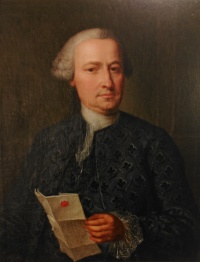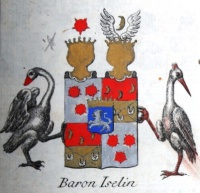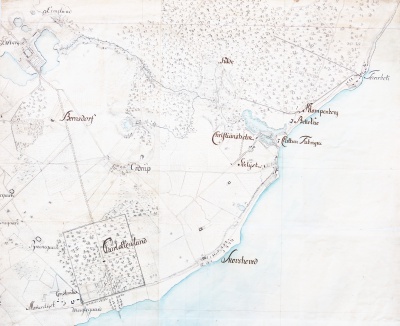Iselin, Reinhard
Born 4.8.1714 in Basel (G. L. Grove's article on Conrad Hauser in Personalhistorisk tidsskrift (PHT) claims that Iselin was born in Brugg in canton Aargau in Switzerland). Died 10.4.1781. Buried at Frederiks German Church in Christianshavn, Copenhagen (?)
Family
Father: Iselin, Johan Ludvig (Brugg), who was involved in the company Gürtlers & Wirts (Swiss Historical Dictionary) External link to Swiss Historical Dictionary
Mother: Schrotberger, Margaretha (?-1755)
Marriage: 9.2.1752 in Copenhagen, German Reformist Church to Fabritius de Tengnagel, Anna Elisabeth, born 20.8.1735 in Copenhagen, died 17.3.1786. Fabritius de Tengnagel, Anna Elisabeth was the daughter of bank commissioner, and director for Asiatisk Kompagni, Fabritius, Michael (1697–1746) and Koster, Anna Maria (1705–1775) (BioLek III)
Children: Daghter Mimi, married to the Count Rantzau, Christian Frederik Ernst (BioLek III). Another source claims her name was Iselin, Marie Margrethe (28.2.1753 - 14.9.1814) and that the couple were married on 14.6.1776 in Copenhagen, but that they were divorced on and Rantzau went on to marry Huth, Charlotte Wilhelmine von (Wikipedia)
Daughter Lisa, married to Calmette, Antoine de la (BioLek III). A collection of letters from Lise/Lisa de la Calmette, born Iselin, to Mrs. M. C. Schiönning dated to roughly 1782-1785 and some that are undated sits in the Royal Library's collection (Håndskriftssamlingen, Schiön 106 a - d, 4o. Breve til og fra M. C. Schiönning). The collection also includes correspondence between Lise de la Calmette, Mimi Rantzau and Ms. Scholten (?).
Timeline
1740: Upon spending some time learning the trade in Basel and Cologne, Iselin came to Copenhagen where he started working for House of Fabritius & Wever (BioLek III)
1746 - Owned or bought the ship FREDERICUS QUINTUS, built in Altona about the same year. 102 cmcl. (Marcussen Ship Database)
1748: September 3. Inducted into the Basel Safran Guild (Weiss-Frey, Fried 'Heinrich Iselin von Rosenfeld und sein Geschlecht', Basel 1909, p. 137).
1749: Through his friend Classen, Johann Friedrich, who owned an armory, Iselin provided the Danish state with gunpowder and saltpeter (Weiss-Frey, Fried 'Heinrich Iselin von Rosenfeld und sein Geschlecht', Basel 1909, p. 137). The profits from this business paved the ground for the stablishment of his own bank- and merchant house, House of Reinhard Iselin & Co. which quickly became one of the most influential merchant houses in Copenhagen (BioLek III) (Swiss Historical Dictionary). The same year Iselin was inducted into the Guild of Wholesale merchants in Copenhagen (Swiss Historical Dictionary)
1754: Established a cloth manufacture (BioLek III)
1755: Granted royal priviledge to print cotton on the Christiansholm estate near Klampenborg (BioLek III)
1755 - ?: Involved in the establishment of the Royal African Company (BioLek III)
1759-1769: Director of Asiatisk Kompagni. (BioLek III)
1760: Justitsraad (Stats-Journal 1769, 23)
1762: Involved with a dispute with the Admiralty Admiralitet, Søetaten & General Commisariats Collegie about a shipment of hemp from Riga, at 4000 lispund. It came to Denmark on board the "coffardi" ship Jægersborg, i.e. a commercial vessel, which held 95 commerce læster. The dispute is over what the Admiralty perceived as the agreed quantity and quality of said good, which it would appear the shipment brought to them by Iselin's company (we must presume) did not live up to. The case continued into 1763. The majority of the related documents are from the Admiralty, but one is from Iselin in which he states that the problem was already evident with the bonitet, i.e. the quality of the specified shipment in Riga. Presumably this was a way for him to try and refuse responsibility. The letter from Iselin is in a wonderful and confusing French and German mixed-up language. A later addition also includes 852 lispund of hemp of the same shipment, but it is not clear how this relates to the initial case. The hemp was to be used by a rebslahger Appleby, Peter whose statements concerning the quality of the hemp appears to have been used in the dispute. Some letters also describe that the dispute was concerned with how the hemp in question was of a different colour than in previous years.
1765-11-3 - Together with Battier, Christopher, Tutein, Peter, and Bruckner, Friderich, he served as godfather for an un-named Moer owned by Wint, Geurt Sprevert de - of the trading company Geurt Spr. de Wint & Comp. The slave was baptised into the Calvinist faith in the Reformist Church chapel of Copenhagen and renamed Reinhard (the same name as his promenent godfather Iselin). (Kiøbenhavns Kongelig alene priviligerede Adresse-Contoirs Efterretninger)
1766: Etatsraad (BioLek III, Stats-Journal 1769, 23)
1766 - Listed as director at Afrikanske Kompagni. (Holck: Dannemarcks Handels=Speil 1766:57)
1769 - Konferensraad (BioLek III)
1772 - Purchased the Ouerlooske tannery (BioLek III)
1776 - Enobled, baron (BioLek III)
1777: In the newspaper "Kiøbenhavns Kongelig alene priviligerede Adresse-Contoirs Efterretninger (1759-1854), the wife of Iselin put in a notice saying that all business of Iselin & Compagnie should "cease", and that curators had taken over the company. It gives no further details of why this is, but clearly this is the onset of the demise of Iselin & Compagnie (Statsbiblioteket electronic newspaper resource)
Property
The Iselingen estate, which was the building otherwise known as Vordingborg Castle estate (Andersen, 2011, 261-265). Part of this was the then expansion of the estate's home farm, which was given the name Rosenfeld (BioLek III). Smidt writes that there are no longer any remnants visible of the Iselin to be identified anywhere on the estate (Andersen, 2011, 261). Upon Reinhard Iselin's death in 1781, the estate was passed on to his daughters, and Iselin Rantzow, Mimi lived the rest of her life on the estate following her divorce in 1793 (Andersen, 2011, 264).
Rosendal (BioLek III)
Rosenvænget in Copenhagen (probably the old Holmsted, Frederik estate where the cotton printing took place) (BioLek III)
A small estate in Lyngby, now Gramlille (BioLek III)
Iselin was considered one of the most affluent merchants, and was therefore also one of the merchants who supplied funds for the state loans at request of Bernstorff, J. H. E.. (BioLek III). Iselin established contact, for credit purposes, between the Danish Court, private Danish costumers and the Swiss Bank Leu (until its merger into Credit Suisse in 2006, one of the oldests banks in Switzerland). (Cooperaxion).


